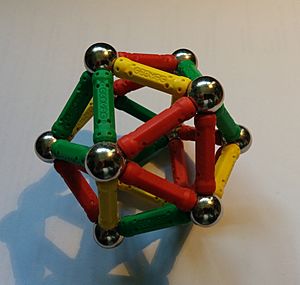Geomag facts for kids
Geomag is a cool construction toy that uses the power of magnets. It comes with small bars that have a strong magnet at each end and metal spheres that are coated in nickel. The magnetic bars and metal balls snap together, letting you build all sorts of amazing shapes and structures.
The toy was invented by Claudio Vicentelli in May 1998. Today, Geomag is made by a company called Geomagworld SA in Novazzano, Switzerland. To follow toy safety rules, the metal spheres were later updated to have a bronze coating instead of just nickel.
The Story of Geomag
A Smart Idea
In 1998, an inventor named Claudio Vicentelli, who was an expert in using magnets, came up with the idea for Geomag. He created a special design for the magnetic bars and metal spheres and got a patent for it. A patent is a way to protect an invention so no one else can copy it.
His main goal was to create a fun magnetic toy without using too much magnetic material. This clever thinking helped make the toy less expensive to produce.
Growing Bigger
Geomag first appeared in an Italian toy store in 1999. A year later, it was shown at big toy fairs in cities like Milan, Nuremberg, and New York. After a while, the inventor, Vicentelli, and his first business partners decided to go their separate ways because they had different ideas for the toy's future.
In 2003, a new Swiss company, Geomag SA, was created in Ticino to make the toy. This company added new pieces to the Geomag sets, like colorful plastic panels. These panels came in shapes like triangles, squares, and pentagons. They could be used to make buildings look cooler and also make them stronger.
In 2004, a new line called G-Baby was made for younger kids. It had magnetic cubes and half-spheres that were safe for toddlers to play with.
Making it Safer
Toy safety is very important. New rules were made in Europe and the USA to protect young children. These rules said that any toy parts small enough to fit inside a special test tube could only be sold to kids aged 14 or older.
Because of this, the company had to change the size of the Geomag bars. The original 27 mm bars were made longer, to 58 mm. The new, longer bars were used for Geomag sets aimed at kids ages 3 and up. The original, smaller version was renamed Geomag PRO and is now sold for teens and adults aged 14 and over.
In 2008, the company was restarted as Geomagworld SA. They continued to make the safer 58 mm bars and introduced more colors and panel pieces. The original 27 mm bars are still made today as part of the Geomag PRO line, which includes different colors and panel options for more advanced builders.
Awards
Geomag has won many awards over the years for being a great toy. Here are some of them:
- 2002 Parents' Choice Award "Geomag"
- 2004 Dr. Toy "The Best Advice on Children’s Products" Geomag - Color - 44 pcs
- 2004 Gold Award Winners Nappa
- 2004 Parents' Choice Award "Geomag Color 96 Kit"
- 2004 Parents' Choice Award "Geomag Panel 125 Kit"
- 2004 Toy Retailer Association "Construction Toy of the Year"
- 2005 Oppenheim Toy Portfolio Best Toy Award Gold Seal
- Parents' Choice Award "Geomag Pastelles 42"
- 2005 Parents' Choice Award "Magnetic Challenge"
- 2005 Tillywig Toy & Media Awards "G333 Glow Moon Explorer"
- 2005 TOTY "Special toy of the year"
- 2006 Parents' Choice Award "Geomag Dynamic Master"
- 2006 Kids Superbrand
- 2012 Editors' Recommended Specialty Toy "GEOMAG E-Motion Power Spin 24 pc"
- 2012 Editors' Recommended Specialty Toy "Geomag Pink - 66 pc"
- 2012 Space Age Award in the category 'Little Scientists.' "Geomag GLOW Moon Explorer"
- 2013 Editors' Recommended Specialty Toy "KOR Geomag - Aki"
See also
 In Spanish: Geomag para niños
In Spanish: Geomag para niños
- Magnetix
- Magnext


